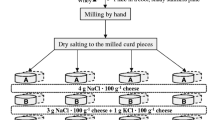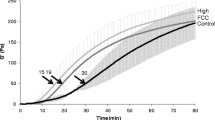Abstract
Recovery of whey proteins, decreasing curd fines losses and improving the ability of curd to hold moisture appear some critical approaches to result in a product with reasonably higher yield. In the present study, attempts were made to increase yield of direct acidified Cottage cheese with the addition of CaCl2 alone as well as in combination with higher heat treatment. The effect of CaCl2 alone added @ 0.012, 0.016 and 0.02 % as well as with high heat treatment at 85, 90 and 95 °C for 5 min on the total protein and whey proteins contents (DM basis), moisture retention and the resultant curd yield as well as the quality of Cottage cheese was studied. It showed that CaCl2 @ 0.02 % significantly (P<0.05) increased the curd yield to 12.76 % against 12.16 % for the control with an additional increase by 4.93 %, mainly because of the increased (P < 0.05) moisture content of 74.80 % compared to the control (74.35 %), while CaCl2 @ 0.02 % along with heat treatment at 90 °C/5 min enhanced (P < 0.05) the curd yield to 13.52 % compared to the control sample by about 11.18 %. The treatment significantly (P<0.05) increased the whey proteins and total protein contents to 13.93 and 87.69 % against the control with the corresponding values being 1.20 and 73.41 %, respectively with an improved (P<0.05) moisture retention of 75.10 % compared to the control (74.35 %).



Similar content being viewed by others
References
ADSA (2004) Cottage cheese score card, 2003 Rules. In: 83rd Annual Collegiate Dairy Products Evaluation Contest. Committee on Dairy Product Evaluation, Amarican Dairy Science Association, p 16
AOAC (2000) In: Horwitz W (ed) Association of Official Analytical Chemists. Official Methods of Analysis, vol II, 17th edn. Assc Official Agric Chem, Washington DC
Chandan RC, Kapoor R (2011) Principles of cheese technology. In: Chandan RC, Kilara A (eds) Dairy ingredients for food processing, 1st edn. Wiley-Blackwell, Ames, Lowa, pp 225–265
Dalgleish DG (1990) The effect of denaturation of β-lactalbumin on renneting-A quantitative study. Milchwissenschaft 45:491–499
de la Fuente MA, Olano A, Casal V, Juárez M (1999) Effects of high pressure and heat treatment on the mineral balance of goats’ milk. J Dairy Res 66:65–72
Dill CW, Roberts WM (1959) Factors controlling curd tension. J Dairy Sci 43:1292–1295
Dill CW, Roberts WM, Monore RJ (1958) Interrelationship of heat treatment, solids not fat and calcium chloride to the yield of Cottage cheese. J Dairy Sci 41:714–717
Dybing ST, Parsons JG, Martin JH, Spurgeon KR (1982) Effect of sodium hexametaphosphate on Cottage cheese yields. J Dairy Sci 65:544–551
Dzurec DJ, Zall RR (1982) Effect of on-farm heating and storage of milk on Cottage cheese yield. J Dairy Sci 65:2296–2300
Emmons DB, Price WV, Swanson AM (1959) Test to measure syneresis and firmness of Cottage cheese coagulum and their application in curd making process. J Dairy Sci 42:866–869
Evanston IL (1990) System of Statistics (SYSTAT). In: Evanston IL (ed) Wilkinson
Guinee TP, Pudja PD, Farkye NY (1993) Fresh acid curd cheese varieties. In: Fox PF (ed) Cheese: chemistry, physics and microbiology, vol 2, 2nd edn. Chapman and Hall, London, pp 363–420
ISO 8586-1 (1993E) Sensory analysis–general guidance for the selection, training and monitoring of assessors. International Organization for Standardization, Geneva
ISO 8589-1 (1988) Sensory analysis–general guidance for the design of test rooms. International Organization for Standardization, Geneva
Kalab M, Allan-Wojtas P, Phipps-Todd BE (1983) Development of microstructure in set-style nonfat yoghurt. Food Microstruct 2:51–66
Makhal S, Giri A, Kanawjia SK (2011) Effect of κ-carrageenan and tetrasodium pyrophosphate on the yield of direct acidified Cottage cheese. J Food Sci Technol doi:10.1007/s13197-011-0438-5
Makhal S, Kanawjia SK, Giri A (2012) Effectiveness of thymol in extending keeping quality of cottage cheese. J Food Sci Technol doi:10.1007/s13197-012-0715-y
Okigbo LM, Richardson GH, Brown RJ, Ernstrom CA (1985) Effects of pH, calcium chloride, and chymosin concentration on coagulation properties of abnormal and normal milk. J Dairy Sci 68:2527–2533
Sawyer WH (1969) Complex between beta-lactoglobulin and kappa-casein. J Dairy Sci 52:1347–1355
Schmidt DG, Poll JK (1986) Electrokinetic measurements on unheated and heated casein micelle systems. Neth Milk Dairy J 40:269–280
Tewari BD, Singh S (1988) Innovation in technology of Cottage cheese. Indian Dairyman 40:199–208
Wolfschoon-Pombo AF (1997) Influence of calcium chloride addition to milk on the cheese yield. Int Dairy J 7:249–254
Author information
Authors and Affiliations
Corresponding author
Rights and permissions
About this article
Cite this article
Makhal, S., Kanawjia, S.K. & Giri, A. Role of calcium chloride and heat treatment singly and in combination on improvement of the yield of direct acidified Cottage cheese. J Food Sci Technol 52, 535–541 (2015). https://doi.org/10.1007/s13197-013-1028-5
Revised:
Accepted:
Published:
Issue Date:
DOI: https://doi.org/10.1007/s13197-013-1028-5




